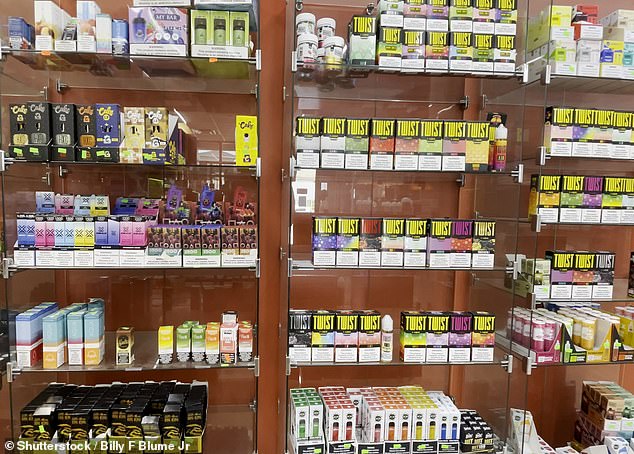More than one in 10 high school students use delta-8 THC, a sibling of the psychoactive chemical in marijuana, a first-of-its-kind analysis shows.
Commonly referred to as ‘diet weed’ because it promises the high without the anxiety, Delta-8 has exploded in popularity among young people who don’t need to show proof of age to buy it.
Of the 12th graders who used Delta-8, 91 percent also reported using marijuana, according to the NIH-funded study.
Scientists now consider the spread of delta-8 products a ‘public health concern’, with lead author Adam Leventhal saying he and other researchers ‘just didn’t expect it to be this high’.

Delta-8 products are not regulated and customers do not need to show proof of age to purchase them. This, in addition to technicolor packaging that appeals to young people, has helped to drive up young people’s use


Delta-8 is cheap and easy to get. Falling prices for the drug appear to coincide with its growing popularity as a ‘safe’ alternative to marijuana
Diet weed has not been thoroughly studied, and its effects on the teenage brain are not well understood.
But it has led to thousands of poisonings each year, poking holes in the argument that delta-8 is a safer alternative to marijuana.
Researchers at the Keck School of Medicine at the University of Southern California, with support from the NIH, conducted the first analysis of its kind on adolescent use of delta-8.
The data reflected use among high school students in 2023 collected as part of the national Monitoring the Future survey, which is funded by the National Institute on Drug Abuse.
About 11 percent of 12th graders — one or two in every average American high school classroom — admitted to using the drug.
As this analysis is the first to examine rates of delta-8 use, the researchers could not determine whether this was higher than in previous years. However, there are strong indications that youth use is on the rise.
Calls to poison centers throughout the United States related to Delta-8 jumped 82 per cent from 2021 to 2022, corresponding to more than 2,300 calls. Over 40 percent of these calls involved children.
Dr. Leventhal told NBC News: ‘We know that high school students naturally want to explore and try new “exciting” things, such as e-cigarettes, alcohol or marijuana.
“It’s not surprising that we see them using delta-8.”
The substance, which often comes in vape form in technicolor packaging to attract young people – the same strategy used by e-cigarette manufacturers – is extremely easy to obtain thanks to a lack of regulation.
Last year, Hofstra University researchers found that over half of 45 delta-8 retail sites sold their products in child-friendly packaging.
Dr. Alyssa Harlow, lead author and professor of public health at the University of Southern California, said: ‘Delta-8 products are out there where teenagers can easily find and buy them, and there needs to be continued monitoring of its use, as well as public health efforts to help young people and parents stay informed and safe.’
The short- and long-term effects on developing brains have not been fully studied.


Delta-8 products are often packaged in such a way that they will be conspicuous and can look as harmless as candy
Delta-8 comes from the hemp plant and is chemically very similar to delta-9 THC in cannabis, except that it binds less strongly to cannabinoid receptors in the brain than delta-9. This explains why it is less psychoactive than delta-9 THC.
It is also believed to cause less paranoia and anxiety than marijuana, adding to its appeal.
Although it hasn’t been studied as extensively, researchers believe it has similar effects on the developing brain as marijuana, which can lead to poor academic performance, difficulty thinking and problem-solving, and even addiction.
Researchers from the University of California, San Diego found earlier this year that 13- to 14-year-olds who had used cannabis in the past year had worse memory than those who had never used the drug.
Similarly, researchers from the University of Vermont scanned the brains of teenagers from England, Ireland, France and Germany to study marijuana’s effects.
They concluded that 14-year-old girls and boys exposed to THC – the psychoactive chemical in cannabis – had a greater amount of gray matter – tissue responsible for muscle control, sensory perception such as seeing and hearing, memory, emotions, speech, decision making and self-control – in their brains.
Their findings signaled that adolescent marijuana use interfered with their brain development.
The study, published in the journal YAMAhas its limitations.
It took into account only those high school-aged seniors who were enrolled in school and did not take into account those who are homeschooled or not currently enrolled in school. It also did not take into account the students who were absent on the day of the survey.
